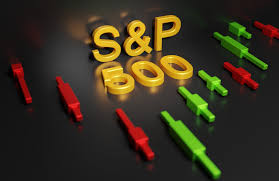
The US stock market is demonstrating its remarkable resilience once again.
Over the past week, the S&P 500 has catapulted an eye-catching 8.98%, catching many off guard and reigniting conversations about the trajectory of this historic bull market.
Traders and investors are finding themselves at a crossroads: is the rally a sustainable reaction to fundamental shifts, or are we on the edge of another bout of volatility, especially as the influential Jackson Hole Economic Symposium draws near?
This article dives deep into the factors driving the recent surge, explores the pivotal role of the Federal Reserve and Jerome Powell’s upcoming address, examines underlying macroeconomic risks, and offers practical guidance for navigating the markets during such high-stakes periods.
I will also explain why staying grounded in fundamentals — and working with experienced mentors — is more crucial than ever.
The last week’s market action has been nothing short of extraordinary. Since early August, the S&P 500 (SPX) soared nearly 9%, buoyed by two key catalysts: growing optimism around potential interest rate cuts by the Federal Reserve and a slew of strong quarterly earnings reports from market heavyweights.
Despite lingering recession fears earlier in the year, many S&P 500 constituents have posted earnings that consistently beat analyst forecasts.
Corporations in the technology, energy, and consumer discretionary sectors, in particular, have outperformed expectations, which has given investors courage to re-enter and add to positions.
- On the precipice of a recession
- US dollar getting stronger: African countries have few policy options
- The green piggy bank on your cell phone
- Apple makes history as first $3 trillion company amid tech stock surge
Keep Reading
For a market that thrives on forward-looking sentiment, positive surprises on both the top and bottom lines are potent fuel.
Perhaps even more significant than earnings has been investors’ renewed faith in the so-called “Fed Put”—the belief that the Federal Reserve will intervene with monetary easing if economic risks escalate.
With inflation showing tentative signs of easing and labour markets revealing subtle cracks, speculation has mounted that the Fed could pivot toward rate cuts sooner than previously anticipated.
This prospect has emboldened both institutional and retail traders to chase risk assets, contributing to the S&P 500’s outsized move.
Every year, the Jackson Hole Economic Symposium attracts policymakers, central bankers, economists, and financial market leaders from around the world.
The 2025 edition, held from August 21-23, is shaping up to be among the most consequential gatherings in years, with Federal Reserve chair Jerome Powell at its epicentre.
What Is Jackson Hole and why does it matter?
Jackson Hole isn’t just a picturesque destination in Wyoming—it’s the site where critical policy signals are often telegraphed to global markets. In years past, Jackson Hole has witnessed major announcements and strategic pivots from the Federal Reserve.
Powell’s speech in August has the potential to clarify, or muddy, the outlook for US interest rates, inflation management, and overall economic strategy.
Key themes to watch
Inflation’s next move: Will Powell signal confidence that inflation is under control, or warn of renewed pressures from wage gains, supply constraints, or global unrest?
Labour market health: Although official unemployment remains low, job creation has slowed and wage growth shows signs of cooling. A softer labour market could tip the scales toward earlier easing.
Rate cut speculation: The market’s rally is partly built on bets that the Fed will cut rates as soon as this fall. Powell’s clarity—or lack thereof—on this front could trigger sharp swings in both directions.
While the recent rally has provided a welcome boost to portfolios, it would be unwise to ignore the storm clouds gathering on the horizon. History is replete with examples of “bull traps”—explosive market rallies that fizzle when hopes are dashed by unexpected policy moves or disappointing data.
Historical seasonal patterns
Late summer is often marked by increased market volatility. August and September have historically been tricky months for stocks, prone to sharp corrections following periods of over-extended bullishness. As investors digest earnings and anticipate major policy meetings, even minor disappointments can trigger outsized reactions.
Risks lurking beneath the surface
Several issues could upend the current euphoria:
Inflation shock: Resurgent inflation, whether from energy price spikes or renewed supply chain disruptions, could prompt a cooling reaction from the Fed.
Geopolitical events: Uncertainty in Ukraine, mounting trade tensions, or unexpected global crises could quickly flip investor sentiment.
Economic downturn: While avoiding recession so far, slowing consumption, weak business investment, or another shock to the banking system remain plausible risk factors.
It’s tempting to chase momentum when the market is running hot.
However, the best investors know the importance of sticking to a disciplined, fundamentals-based approach. Look beyond market noise, keep your focus on company balance sheets, earnings growth, and sectoral trends. This is how you protect your capital when volatility inevitably returns.
With so much uncertainty in the macro environment, prudent risk management is paramount.
- Keep position sizing sensible
Don’t let a rally lure you into overexposure. Review your portfolio and ensure individual positions, especially in volatile sectors, remain within reasonable bounds.
- Watch the data, not headlines
Let the numbers guide your decisions. Follow key economic indicators (jobs, inflation, consumer spending) and corporate fundamentals, rather than chasing rumors or short-lived narratives.
- Stay nimble, but don’t panic
It’s fine to rotate into safer or more attractive sectors as macro conditions fluctuate. But don’t abandon your core investing principles because of short-term volatility.
- Use downturns as opportunities
Sharp pullbacks in quality stocks often create rare buying windows. As long as the business remains sound, use dips to add to your holdings.
The financial markets reward the prepared. In complex times, personalized coaching can make the difference between consistent gains and costly mistakes. At Streetwise Economics, we offer one-on-one coaching in trading and investing, designed for both beginners and seasoned investors seeking an edge. If you want to:
Build a resilient portfolio grounded in strong fundamentals.
Learn time-tested trading psychology and risk management.
Identify overlooked opportunities and avoid expensive pitfalls.
Visit www.streetwiseeconomics.com to book your 1:1 coaching session today. Our expert coaches will tailor strategies to your goals, experience, and risk appetite.
Markets move fast, and staying informed is half the battle. For timely video insights, deep-dive analyses, and actionable strategies from top experts, subscribe to the Streetwise Economics YouTube channel. Our latest videos break down market-moving events, decode Federal Reserve signals, and showcase real-world investment case studies in easy-to-follow formats.
The S&P 500’s 8.98% rally is a testament to the enduring power of optimism and the influence of the Federal Reserve on financial markets. But as the Jackson Hole symposium looms, reality checks are inevitable. The most successful investors in times like these are those who stay disciplined, remain attentive to fundamentals, and never stop learning.
Take this opportunity to reassess your strategies, learn from experienced mentors, and keep absorbing the best ideas—both from market history and today’s smartest thinkers. The road ahead is sure to be volatile, but with the right preparation, you can turn challenges into opportunities and thrive no matter what comes next.
Ready to become a more informed, disciplined trader or investor?
Book your personal coaching session at www.streetwiseeconomics.com
Get daily, actionable market insights by subscribing to Streetwise Economics on YouTube
Markets don’t wait — why should you?
Until next time, trade and Invest wisely and may the markets be on your side.
*Isaac Jonas is an economist based in Canada and principal consultant at Streetwise Economics. He is also a retail investor, retail trader and content creator, focusing mainly on the US and Canadian capital markets. He regularly shares insights via his social media handles and YouTube Channel (Streetwise Economics). His website is www.streetwiseeconomics.com and can be reachable on [email protected]. Disclaimer: This article reflects data and market conditions as of July 30, 2025. Always consider your personal circumstances and risk tolerance before acting on any financial information. Let’s keep learning and adapting—together.











